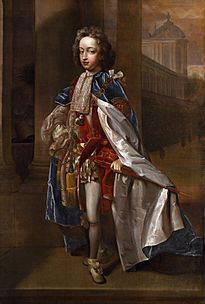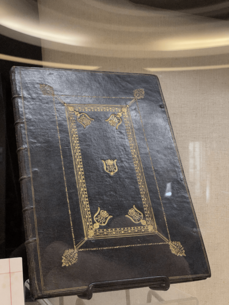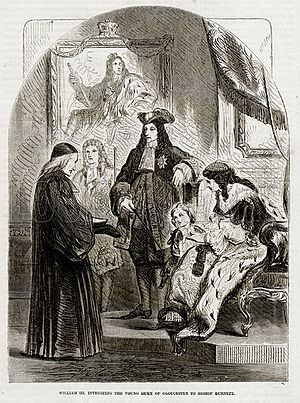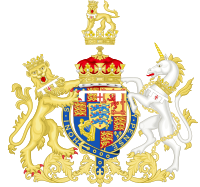Prince William, Duke of Gloucester facts for kids
Quick facts for kids Prince William |
|
|---|---|
| Duke of Gloucester | |

Portrait by Sir Godfrey Kneller, c. 1700
|
|
| Born | 24 July 1689 Hampton Court Palace, London |
| Died | 30 July 1700 (aged 11) Windsor Castle, Windsor, Berkshire |
| Burial | 9 August 1700 Westminster Abbey |
| House | Oldenburg |
| Father | Prince George of Denmark |
| Mother | Anne Stuart (later Anne, Queen of Great Britain) |
Prince William, Duke of Gloucester (born July 24, 1689 – died July 30, 1700) was a very important young prince in English history. He was the only child of Princess Anne (who later became Queen Anne) and her husband, Prince George of Denmark, to live past infancy.
William was known as the Duke of Gloucester. His birth was a big deal because it helped secure the Protestant line of succession to the throne. This was especially important after the "Glorious Revolution" of 1688, which removed his Catholic grandfather, James II & VII, from power.
Even though his mother Anne had disagreements with her uncle and aunt, King William III and Queen Mary II, William became close to them. King William made him a Knight of the Garter. Queen Mary often sent him gifts.
At his home, Campden House in Kensington, William became friends with his Welsh servant, Jenkin Lewis. Lewis wrote down many memories of the Duke, which are helpful for historians today. William also had his own mini-army called the "Horse Guards," made up of about 90 boys.
William's health was always a concern for his mother. His death at age 11 caused a big problem for the royal succession. His mother was the only Protestant heir left. To prevent a Catholic from taking the throne, the English Parliament passed the Act of Settlement 1701. This law named Electress Sophia of Hanover and her Protestant family as the next in line for the throne.
Contents
A Prince is Born: His Early Life and Health
In 1688, a major event called the Glorious Revolution happened. The Catholic King James II was removed from the throne. His Protestant nephew and son-in-law, William III of Orange, became king along with James's elder daughter, Mary.
Since King William and Queen Mary had no children, Mary's younger sister, Anne, was named the next in line. This plan was made official in the Bill of Rights 1689.
Princess Anne had been pregnant many times before, but her babies either didn't survive or died very young. Her seventh pregnancy resulted in the birth of Prince William on July 24, 1689, at Hampton Court Palace. Many important people, including the King and Queen, were there for his birth.
Three days later, the baby was named William Henry after his uncle, King William. The King declared him the Duke of Gloucester, though this title was never officially created. William was second in line to the throne after his mother. His birth gave hope to those who supported the Protestant succession.
Many songs and odes were written to celebrate his birth and later birthdays. However, those who supported King James II, called the Jacobites, saw William as a "sickly and doomed usurper."
William was described as a "brave lively boy," but he became ill with convulsions when he was three weeks old. His mother moved him to Craven House in Kensington, hoping the fresh air would help. These convulsions might have been from meningitis, which could have caused hydrocephalus (fluid on the brain).
Like other royal children, William was cared for by a governess, Lady Fitzhardinge, and a wet nurse, Mrs. Pack. To help his health, he was driven outside daily in a small carriage pulled by Shetland ponies. This seemed to help him, so his parents bought a permanent home nearby, Campden House, in 1690. Here, he became friends with Jenkin Lewis, his body-servant.
William often had a fever, which was treated with Jesuit's bark (an early form of quinine). He hated this medicine and often threw it up. Because of his possible hydrocephalus, he had a large head. Surgeons sometimes pierced his head to drain fluid. He also struggled to walk properly and would stumble.
When he was almost five, William refused to climb stairs without help. His father, Prince George, made him walk on his own. This kind of strict discipline was common at the time.
Learning and Growing Up
William learned to speak later than most children, not speaking clearly until he was three. So, his lessons started a year later. In 1693, Reverend Samuel Pratt became his tutor. William studied geography, math, Latin, and French.
Pratt and Jenkin Lewis, William's favorite servant, often disagreed about how William should be taught. William preferred Lewis because he knew a lot about military things. This helped William with his "Horse Guards," his miniature army of local boys. This army grew from 22 boys to over 90 boys in a few years.
Princess Anne had disagreements with King William and Queen Mary. Her friend, the Countess of Marlborough, suggested that William should visit his aunt and uncle often. This would help keep their relationship friendly.
To try and fix the family disagreements, Anne invited the King and Queen to watch William's "Horse Guards" drill. The King was impressed and visited Campden House the next day. William grew closer to his aunt and uncle. Queen Mary often bought him toys from his favorite shop.
When Queen Mary died in 1694, Anne and William had a small reconciliation. This led to William moving to St James's Palace in London. As William grew older, he saw less of Jenkin Lewis.
On his seventh birthday, William became a knight of the Order of the Garter. King William had given him this honor six months earlier. William felt ill during the celebration banquet but later recovered. He went deer hunting in Windsor Great Park.
Princess Anne wrote to her friend, "My boy continues yet very well, and looks better, I think, than ever he did in his life; I mean more healthy, for though I love him very well, I can't brag of his beauty."
In 1696, a plot to kill King William was discovered. William, Duke of Gloucester, signed a letter to the King showing his loyalty. He wrote, "I, your Majesty's most dutiful subject, had rather lose my life in your Majesty's cause than in any man's else." The boys in his army also added, "We, your Majesty's subjects, will stand by you while we have a drop of blood."
In 1697, Parliament gave money to set up William's own royal household. King William appointed Gilbert Burnet, the Bishop of Salisbury, as William's main teacher. Anne was not happy with this choice at first, but the King insisted. The Earl of Marlborough, a friend of Anne's, became William's governor.
Bishop Burnet taught William for hours about history and law. He encouraged William to memorize facts and dates. Government officials checked William's progress every few months and were amazed by his "wonderful memory and good judgement." His childhood army was disbanded, and King William made him an honorary commander of a real Dutch army regiment.
His Final Days
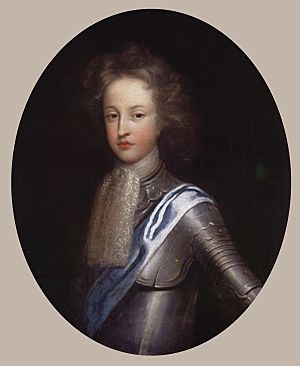
As William neared his eleventh birthday, he moved into rooms at Kensington Palace that his aunt, Queen Mary, had used. On his birthday, July 24, 1700, at Windsor, he felt very tired. People thought he might have just gotten too hot from dancing.
But by nightfall, he had a sore throat and chills. The next day, he had a bad headache and a high fever. A doctor arrived on July 27. William was immediately bled, a common treatment then, but his condition worsened. He developed a rash and diarrhoea. More doctors arrived, but they couldn't agree on what was wrong.
One doctor thought it was scarlet fever, while others thought it was smallpox. They gave him medicines and continued to bleed him, which one doctor strongly disagreed with. William was in great pain. His mother, Anne, stayed by his side for a whole day and night.
On July 29, William seemed to get a little better, breathing more easily. But this improvement didn't last. That evening, he struggled to breathe and swallow. Prince William died just before 1 a.m. on July 30, 1700, with his parents beside him. The doctors decided he died from a "malignant fever."
An autopsy showed swelling in his neck and too much fluid in his brain. Modern doctors think he might have died from smallpox or a severe bacterial infection, possibly with pneumonia. Even if he had lived, his hydrocephalus would likely have caused serious health problems later.
King William, who was in the Netherlands, wrote that William's death was "so great a loss to me as well as to all England." Anne was heartbroken and stayed in her room, overcome with grief.
William's body was moved to Westminster Abbey, where he was buried on August 9. His parents did not attend the funeral, as was common for royalty in mourning.
William's death was a big problem for the royal succession. His mother, Anne, was the only Protestant heir left. Although Anne had ten more pregnancies after William, none of her other children lived long. To make sure a Catholic would not become king or queen, the English Parliament passed the Act of Settlement 1701. This law named Sophia, Electress of Hanover, a cousin of King James II, and her Protestant family as the next in line for the throne.
Anne became Queen in 1702 and ruled until 1714. Sophia died just a few weeks before Anne. So, Sophia's son, George, became the first British monarch from the House of Hanover.
Titles and Symbols
William was known as His Royal Highness Prince William, Duke of Gloucester. This title ended when he died.
Honors
- KG: Knight of the Garter, January 6, 1696
Arms
William used the royal arms. These arms had a special shield in the middle with the Danish coat of arms. They also had a white "label" with three points, and the middle point had a red cross.
Images for kids
-
Portrait by Edmund Lilly of Prince William in the mantle of the Order of the Garter, c. 1698



